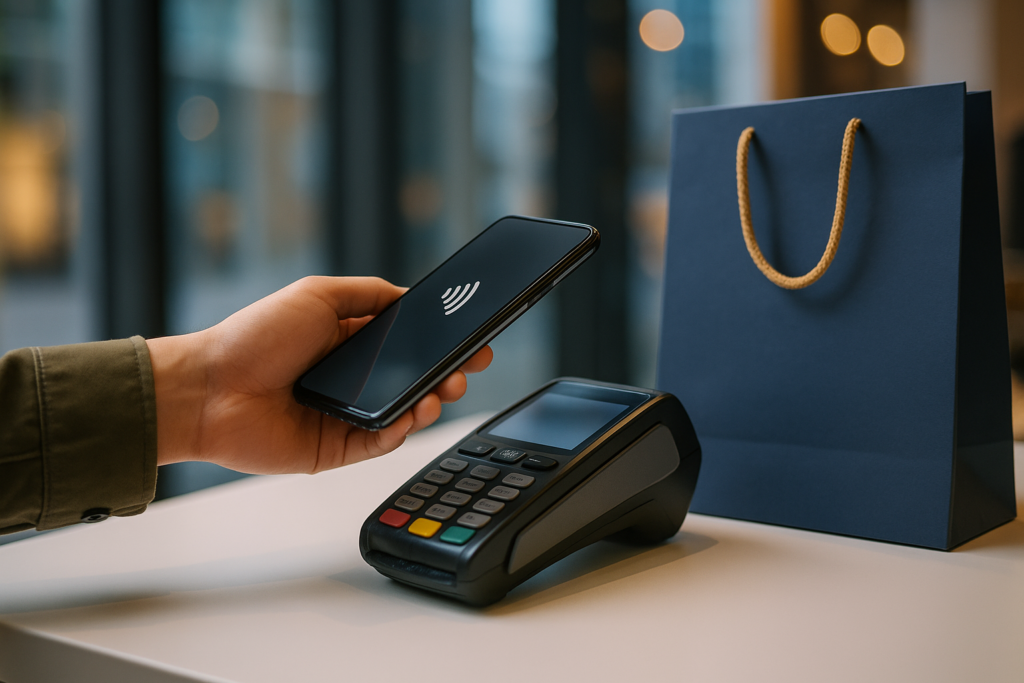Over the past few years, the way consumers make transactions has shifted dramatically. Contactless payments, once a futuristic concept, have become a fundamental part of daily commerce. Recent data shows that a staggering 95% of US merchants now accept tap‑to‑pay options, reflecting a broad shift toward safer, more convenient, and faster payment methods. This evolution benefits consumers and businesses alike, making transactions smoother and reducing reliance on cash or traditional card swipes.
What Are Contactless Payments?
Contactless payments are digital transactions that use radio frequency identification (RFID) or near-field communication (NFC) technology to authorize payments. Instead of inserting or swiping a card, users simply tap their contactless-enabled credit/debit card or mobile device, such as a smartphone or smartwatch, on a compatible payment terminal. The process is quick and secure, often completing in just a few seconds.
Why Are Contactless Payments Becoming Mainstream?
- Speed and Convenience: Transactions are completed faster. For busy environments like restaurants or transit, this speeds up queues and improves customer experience.
- Enhanced Hygiene: Especially during the COVID-19 pandemic, contactless payments reduced physical contact, making them a safer option.
- Security: Contactless transactions use encryption and dynamic security codes. Moreover, many cards and devices implement tokenization, adding an extra layer of protection.
- Adaptability: Mobile wallets like Apple Pay, Google Pay, and Samsung Pay enable users to store multiple cards digitally, offering greater flexibility.
What Does 95% Acceptance Mean for Consumers?
The high acceptance rate indicates that the majority of merchants are equipped with the necessary terminals for tap‑to‑pay. This reduces the inconvenience of carrying cash or swiping cards for small purchases. For consumers, it translates into a seamless experience, whether shopping at a local grocery store, dining out, or paying for public transit.
How Businesses Can Benefit from Contactless Payments
- Faster Checkout: Reduces wait times and improves customer satisfaction.
- Lower Cash Handling Costs: Fewer cash transactions mean less handling and counting, decreasing operational costs and risks.
- Data Collection: Digital payments provide valuable insights into consumer behavior and preferences.
- Stay Competitive: Offering modern payment options attracts tech-savvy customers.
Implementing Contactless Payments: A Guide for Merchants
- Evaluate the existing payment infrastructure and invest in NFC-enabled terminals.
- Ensure your payment systems meet security standards set by industry authorities such as PCI DSS.
- Train staff to educate customers about tap‑to‑pay options and troubleshoot common issues.
- Promote the new payment method through signage and customer communication channels.
- Monitor transaction data to optimize operational efficiencies and customer experience.
Future Outlook for Contactless Payments
The trend points toward even greater adoption. Innovations like biometric authentication, increased device compatibility, and advancements in biometric security will likely drive growth further. Governments and payment networks are also pushing for cashless societies, which will reinforce the shift toward digital, contactless points of sale.
Frequently Asked Questions
1. Are contactless payments safe?
Yes, they employ encryption, tokenization, and dynamic security codes, making them more secure than traditional swipe or cash transactions.
2. Can I use my smartphone for contactless payments?
Absolutely. Most smartphones with NFC technology can be linked to digital wallets like Apple Pay or Google Pay, allowing you to tap and pay with your device.
3. What is the maximum amount I can pay with contactless cards?
Limits vary by country and provider. In the US, many cards have a cap of $100 or $200 per transaction, but this can sometimes be increased with authentication methods.
4. Will contactless payments replace cash entirely?
While contactless payments are growing rapidly, cash will still remain relevant for certain transactions, especially in areas with limited digital infrastructure.
5. How do I apply for a contactless card or set up mobile payments?
You can apply for a new contactless credit or debit card through your bank or credit card provider. For mobile payments, download a compatible digital wallet app and link your existing cards.
If you want to explore the best credit cards with contactless features, visit our Find My Card page. To learn more about recent banking trends, check out our blog.
As contactless payments continue to become the norm, understanding how to use and benefit from this technology can make your everyday transactions more straightforward and secure. Embrace this digital shift and enjoy faster, safer payments today!

